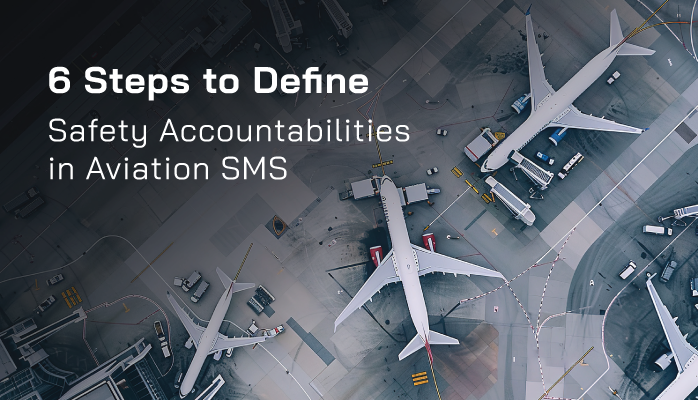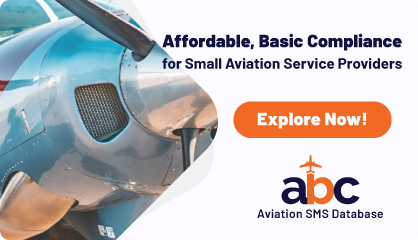Define Safety Accountabilities in Aviation SMS

Aviation demands unwavering commitment to safety, and a robust Safety Management System (SMS) is the foundation for achieving it. For aviation safety managers, establishing clear safety accountabilities within the SMS is critical to
- fostering a proactive safety culture,
- meeting regulatory requirements, and
- mitigating risks.
This guide explores how to define safety accountabilities in an aviation SMS, offering practical steps, best practices, and insights to enhance your organization’s safety performance.
Why Safety Accountabilities Matter in Aviation SMS
Aviation SMS, as mandated by the International Civil Aviation Organization (ICAO) and national regulators like the FAA and EASA, is a top-down, systematic approach to managing safety risks. At its core, an SMS relies on clearly defined roles and responsibilities to ensure that safety policies are implemented effectively. Without defined accountabilities, confusion arises, tasks are overlooked, and safety risks escalate.
Related Aviation Duties and Responsibilities Articles
- Distinguishing Between Responsibility, Authority, and Accountability in Your Aviation SMS
- Advanced Aviation SMS: Explicit Duties Impact Financial Business Success
- Advanced Aviation SMS: Rewriting Duties to Align with Business Goals
Safety accountabilities assign specific responsibilities to individuals or teams, ensuring that everyone understands their role in maintaining safe operations. This clarity drives accountability, improves communication, and aligns the organization with regulatory standards. For safety managers, defining these accountabilities is a strategic step toward building a robust safety culture. SMS Pro includes a dedicated module for defining "duties and responsibilities" with features to ensure employees acknowledge their understanding of their expected safety duties and responsibilities.
Key Benefits of Defined Safety Accountabilities
- Enhanced Compliance: Meet ICAO Annex 19 and local regulatory requirements.
- Improved Risk Management: Ensure hazards are identified and mitigated promptly.
- Stronger Safety Culture: Foster employee engagement and ownership of safety.
- Operational Efficiency: Streamline processes by eliminating role ambiguity.
Steps to Define Safety Accountabilities in Aviation SMS

Defining safety accountabilities requires a structured approach that aligns with your organization’s SMS framework. Below are actionable steps to guide aviation safety managers through the process.
1. Understand Regulatory and Organizational Requirements
Begin by reviewing regulatory guidelines, such as ICAO Annex 19, FAA Part 5, or EASA’s SMS requirements. These standards outline the need for clear safety accountabilities at all levels, from senior management to frontline staff. Next, assess your organization’s operational structure, including departments, processes, and existing safety policies. This ensures that accountabilities align with both regulatory expectations and your unique operational needs.
2. Identify Key Roles and Responsibilities
Map out the key roles within your organization that contribute to safety. These typically include:
- Senior Management: Accountable for setting safety policies, allocating resources, and promoting a safety culture.
- Safety Manager: Oversees SMS implementation, monitors performance, and coordinates safety activities.
- Department Heads: Ensure safety procedures are followed within their units (e.g., flight operations, maintenance).
- Frontline Staff: Report hazards, adhere to safety protocols, and participate in safety training.
- Safety Committees: Review safety data, recommend improvements, and facilitate communication.
For each role, define specific responsibilities. For example, a safety manager might be tasked with conducting risk assessments, while pilots are responsible for reporting incidents via the SMS reporting system.
3. Develop a Safety Accountability Framework
Create a formal framework to document safety accountabilities. This can be a standalone document or integrated into your SMS manual. The framework should include:
- Role Descriptions: Clearly outline each role’s safety-related duties.
- Reporting Lines: Specify who each role reports to for safety matters.
- Performance Metrics: Define how accountability will be measured (e.g., timely hazard reporting, audit completion rates).
- Escalation Procedures: Detail how unresolved safety issues are escalated to higher levels.
Use clear, concise language to ensure the framework is accessible to all employees. For example:
“The Chief Pilot is accountable for ensuring all flight crew complete annual SMS training and report hazards within 24 hours of identification.”
4. Engage Stakeholders and Communicate Expectations

Effective safety accountabilities require buy-in from all levels of the organization. Engage stakeholders—senior leaders, department heads, and frontline staff—early in the process. Hold workshops or meetings to explain the importance of safety accountabilities and gather feedback on proposed roles.
Once the framework is finalized, communicate it clearly through:
- Training Programs: Incorporate accountability expectations into SMS training.
- Internal Communications: Use emails, posters, or briefings to reinforce roles.
- Accessible Documentation: Make the framework available via your SMS portal or intranet.
5. Integrate Accountabilities Into Daily Operations
Embed safety accountabilities into everyday processes to ensure they are actionable. For example:
- Include safety responsibilities in job descriptions and performance reviews.
- Link accountabilities to specific SMS processes, such as hazard reporting, risk assessments, or audits.
- Use checklists or software tools to track compliance with assigned duties.
Aviation SMS software, like Safety-QA or SMIC, can help automate accountability tracking by assigning tasks, sending reminders, and generating performance reports.
6. Monitor and Review Accountabilities
Safety accountabilities are not static; they must evolve with your organization and regulatory changes. Establish a process for regular review, such as:
- Annual SMS Audits: Assess whether accountabilities are being met and identify gaps.
- Safety Performance Indicators (SPIs): Track metrics like hazard reporting rates or training completion.
- Feedback Mechanisms: Encourage employees to provide input on accountability challenges.
Use audit findings and feedback to refine the framework, ensuring it remains relevant and effective.
Best Practices for Defining Safety Accountabilities
To maximize the impact of your safety accountability framework, consider these best practices:
- Align with Safety Objectives: Ensure accountabilities support your SMS goals, such as reducing incidents or improving reporting rates.
- Keep It Simple: Avoid overly complex descriptions that could confuse employees.
- Promote Transparency: Make accountabilities visible to all staff to build trust.
- Leverage Technology: Use SMS software to streamline accountability tracking and reporting.
- Lead by Example: Senior management should model accountability to inspire others.
Overcoming Common Challenges
Defining safety accountabilities can face hurdles, but proactive strategies can address them:
- Resistance to Change: Overcome reluctance by emphasizing the benefits of clarity and safety.
- Resource Constraints: Prioritize high-impact accountabilities and phase in others as resources allow.
- Ambiguity in Roles: Use collaborative workshops to clarify overlapping responsibilities.
- Lack of Engagement: Foster a positive safety culture through recognition programs and open communication.
Conclusion: Building a Safer Future With Clear Accountabilities
For aviation safety managers, defining safety accountabilities is a cornerstone of an effective SMS. By establishing clear roles, communicating expectations, and integrating accountabilities into daily operations, you can enhance compliance, reduce risks, and cultivate a safety-first culture. Start by assessing your organization’s needs, engaging stakeholders, and building a framework that empowers every employee to contribute to safety. With a well-defined accountability structure, your SMS will not only meet regulatory standards but also drive operational excellence.
Ready to strengthen your SMS? Review your current safety accountabilities today and take the first step toward a safer, more accountable aviation operation.






